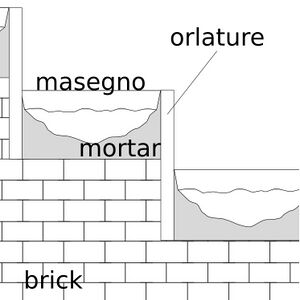Bridge Step: Difference between revisions
Created page with "right|thumb|Cross section of a bridge step Bridge steps and landings follow the same structure and only differ in the width. Steps are usually about ..." |
No edit summary |
||
| Line 1: | Line 1: | ||
[[File:Bridge_step.jpg|right|thumb|Cross section of a bridge step]] | [[File:Bridge_step.jpg|right|thumb|Cross section of a bridge step]] | ||
Bridge steps and landings follow the same structure and only differ in the width. | '''Bridge steps''' and landings follow the same structure and only differ in the width. Steps are usually about 30 cm wide and landings are 2-3 times wider. Steps and landings of a [[wood bridge]] and [[metal bridge]] are simple while the step of a traditional [[masonry bridge]] is more complex. | ||
== Masonry | == Masonry bridge step structure == | ||
The [[ | The [[masonry bridge]] step is built upon the foundation of the [[bridge]]. The facade of every step is made of a white stone that resembles but is not [[istria stone]]. This stone is 26 cm tall. However only 12-16 cm is exposed, while the rest is buried into the bridge foundation. These stones are 7 cm deep.<ref> Ing. Michele Regini. Insula SpA, Dec 2011 </ref> | ||
In the gaps created by these stones, the steps and landings are constructed (''see diagram''). [[Mortar]] fill is dumped on top of the base brick and the [[masegni]] are laid on top of this. Steps are composed of a single ''corso'', or "run," of [[masegni]], while landings, depending on how long, are composed of multiple runs of [[masegni]] following the same rules and patterns of [[street pavement]].<ref> | |||
The Building Blocks of Venice: Preserving knowledge of a city's infrastructure and maintenance. Worcester Ma. Worcester Polytechnic Institute.2011 | The Building Blocks of Venice: Preserving knowledge of a city's infrastructure and maintenance. Worcester Ma. Worcester Polytechnic Institute.2011 | ||
[https://sites.google.com/site/venicemaintained/proposal] | [https://sites.google.com/site/venicemaintained/proposal] | ||
Latest revision as of 16:44, 16 June 2014

Bridge steps and landings follow the same structure and only differ in the width. Steps are usually about 30 cm wide and landings are 2-3 times wider. Steps and landings of a wood bridge and metal bridge are simple while the step of a traditional masonry bridge is more complex.
Masonry bridge step structure
The masonry bridge step is built upon the foundation of the bridge. The facade of every step is made of a white stone that resembles but is not istria stone. This stone is 26 cm tall. However only 12-16 cm is exposed, while the rest is buried into the bridge foundation. These stones are 7 cm deep.[1]
In the gaps created by these stones, the steps and landings are constructed (see diagram). Mortar fill is dumped on top of the base brick and the masegni are laid on top of this. Steps are composed of a single corso, or "run," of masegni, while landings, depending on how long, are composed of multiple runs of masegni following the same rules and patterns of street pavement.[2].